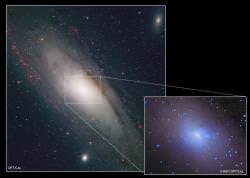NASA’s Chandra X-Ray Observatory took this image of the Andromeda Galaxy (aka M31), the closest major galaxy to the Milky Way. The wider-field image is in optical, and then the zoomed in region is a composite X-ray and optical light image. The purpose of the research was to find X-ray regions and point sources in M31’s central core.
The diffuse blue glow around the centre of the galaxy comes from hot, bright gas. The bright point sources are mostly binary stars interacting with one another. In some situations, a white dwarf is gathering material from a companion star. When too much gas piles up, an explosion occurs on the surface of the white dwarf, which astronomers see as a flash of X-rays called a nova.
By studying these novae for a long period of time, using multiple X-ray observatories, astronomers discovered that many of these novae last for a surprisingly short amount of time. This means that many novae were probably missed during previous observations.
One theory is that the shorter novae occur on the white dwarfs that are the highest mass, and could be ready to explode as type 1a supernovae.
Original Source: Chandra News Release

